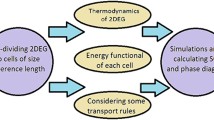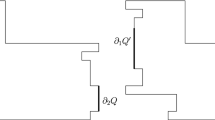Abstract
We analyze a deterministic cellular automaton σ ⋅=(σ n:n≥0) corresponding to the zero-temperature case of Domany's stochastic Ising ferromagnet on the hexagonal lattice \(\mathbb{N}\). The state space \(\mathcal{S}_\mathbb{H} = \left\{ { - 1, + 1} \right\}^\mathbb{H}\) consists of assignments of −1 or +1 to each site of \(\mathbb{H}\) and the initial state \(\sigma ^0 = \left\{ {\sigma _{^x }^0 } \right\}_{x \in \mathbb{H}}\) is chosen randomly with P(σ 0 x=+1)=p∈[0,1]. The sites of \(\mathbb{H}\) are partitioned in two sets \(\mathcal{A}\) and \(\mathcal{B}\) so that all the neighbors of a site x in \(\mathcal{A}\) belong to \(\mathcal{B}\) and vice versa, and the discrete time dynamics is such that the σ ⋅ x 's with \({x \in \mathcal{A}}\) (respectively, \(\mathcal{B}\)) are updated simultaneously at odd (resp., even) times, making σ ⋅ x agree with the majority of its three neighbors. In ref. 1 it was proved that there is a percolation transition at p=1/2 in the percolation models defined by σ n, for all times n∈[1,∞]. In this paper, we study the nature of that transition and prove that the critical exponents β, ν, and η of the dependent percolation models defined by σ n, n∈[1,∞], have the same values as for standard two-dimensional independent site percolation (on the triangular lattice).
Similar content being viewed by others
REFERENCES
F. Camia, C. M. Newman, and V. Sidoravicius, Approach to fixation for zero-temperature stochastic Ising models on the hexagonal lattice, in In and Out of Equilibrium: Probability with a Physics Flavor, V. Sidoravicius, ed., Progress in Probability, Vol. 51 (Birkhä;user, 2002), pp. 163–183.
E. Domany, Exact results for two-and three-dimensional Ising and Potts models, Phys. Rev. Lett. 52:871–874 (1984).
C. D. Howard and C. M. Newman, The percolation transition for the zero-temperature stochastic Ising model on the hexagonal lattice, J. Stat. Phys. 111:57–72 (2003).
B. Nienhuis, private communication (2001).
F. Camia, C. M. Newman, and V. Sidoravicius, Cardy’;s formula for some dependent percolation models, Bull. Brazilian Math. Soc. 33:147–156 (2002).
F. Camia, C. M. Newman, and V. Sidoravicius, A particular bit of universality: Scaling limits of some dependent percolation models, Commun. Math. Phys. to appear.
J. L. Cardy, Critical percolation in finite geometries, J. Phys. A 25:L201–L206 (1992).
S. Smirnov, Critical percolation in the plane: Conformal invariance, Cardy’;s formula, scaling limits, C. R. Acad. Sci. Paris 333:239–244 (2001).
O. Schramm, Scaling limits of loop-erased random walks and uniform spanning trees, Israel J. Math. 118:221–288 (2000).
S. Smirnov and W. Werner, Critical exponents for two-dimensional percolation, Math. Rev. Lett. 8:279–744 (2001).
F. Camia, E. De Santis, and C. M. Newman, Clusters and recurrence in the two-dimensional zero-temperature stochastic Ising model, Ann. Appl. Probab. 12:565–580 (2002).
L. R. Fontes, R. H. Schonmann, and V. Sidoravicius, Stretched exponential fixation in stochastic Ising models at zero temperature, Commun. Math. Phys. 228:495–518 (2002).
A. Gandolfi, C. M. Newman, and D. L. Stein, Zero-temperature dynamics of ± J spin glasses and related models, Commun. Math. Phys. 214:373–387 (2000).
S. Nanda, C. M. Newman, and D. L. Stein, Dynamics of Ising spin systems at zero temperature, in On Dobrushin’;s Way (from Probability Theory to Statistical Mechanics), R. Minlos, S. Shlosman, and Y. Suhov, eds. (AMS, Providence, 2000).
C. M. Newman and D. L. Stein, Blocking and persistence in zero-temperature dynamics of homogeneous and disordered Ising models, Phys. Rev. Lett. 82:3944–3947 (1999).
C. M. Newman and D. L. Stein, Equilibrium pure states and nonequilibrium chaos, J. Stat. Phys. 94:709–722 (1999).
C. M. Newman and D. L. Stein, Zero-temperature dynamics of Ising spin systems following a deep quench: results and open problems, Physica A 279:156–168 (2000).
C. D. Howard, Zero-temperature Ising spin dynamics on the homogeneous tree of degree three, J. Appl. Probab. 37:736–747 (2000).
J. L. Lebowitz, C. Maes, and E. R. Speer, Statistical mechanics of probabilistic cellular automata, J. Stat. Phys. 59:117–170 (1990).
A. J. Bray, Theory of phase ordering kinetics, Adv. Phys. 43:565–580 (1994).
G. R. Grimmett, Percolation, second edition (Springer, Berlin, 1999).
G. F. Lawer, O. Schramm, and W. Werner, One-arm exponent for critical 2D percolation, Electr. J. Probab. 7:000-000 (2002).
Author information
Authors and Affiliations
Rights and permissions
About this article
Cite this article
Camia, F., Newman, C.M. The Percolation Transition in the Zero-Temperature Domany Model. Journal of Statistical Physics 114, 1199–1210 (2004). https://doi.org/10.1023/B:JOSS.0000013965.36344.75
Issue Date:
DOI: https://doi.org/10.1023/B:JOSS.0000013965.36344.75




